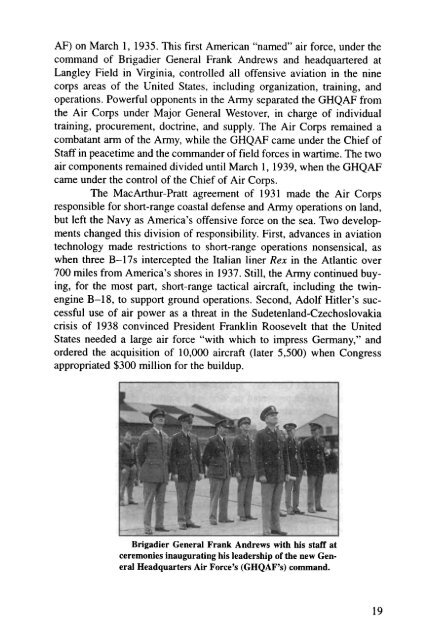A Concise History of the US Air Force - Air Force Historical Studies ...
A Concise History of the US Air Force - Air Force Historical Studies ...
A Concise History of the US Air Force - Air Force Historical Studies ...
Create successful ePaper yourself
Turn your PDF publications into a flip-book with our unique Google optimized e-Paper software.
AF) on March 1, 1935. This first American “named” air force, under <strong>the</strong><br />
command <strong>of</strong> Brigadier General Frank Andrews and headquartered at<br />
Langley Field in Virginia, controlled all <strong>of</strong>fensive aviation in <strong>the</strong> nine<br />
corps areas <strong>of</strong> <strong>the</strong> United States, including organization, training, and<br />
operations. Powerful opponents in <strong>the</strong> Army separated <strong>the</strong> GHQAF from<br />
<strong>the</strong> <strong>Air</strong> Corps under Major General Westover, in charge <strong>of</strong> individual<br />
training, procurement, doctrine, and supply. The <strong>Air</strong> Corps remained a<br />
combatant arm <strong>of</strong> <strong>the</strong> Army, while <strong>the</strong> GHQAF came under <strong>the</strong> Chief <strong>of</strong><br />
Staff in peacetime and <strong>the</strong> commander <strong>of</strong> field forces in wartime. The two<br />
air components remained divided until March 1, 1939, when <strong>the</strong> GHQAF<br />
came under <strong>the</strong> control <strong>of</strong> <strong>the</strong> Chief <strong>of</strong> <strong>Air</strong> Corps.<br />
The MacArthur-Pratt agreement <strong>of</strong> 1931 made <strong>the</strong> <strong>Air</strong> Corps<br />
responsible for short-range coastal defense and Army operations on land,<br />
but left <strong>the</strong> Navy as America’s <strong>of</strong>fensive force on <strong>the</strong> sea. Two develop-<br />
ments changed this division <strong>of</strong> responsibility. First, advances in aviation<br />
technology made restrictions to short-range operations nonsensical, as<br />
when three B-17s intercepted <strong>the</strong> Italian liner Rex in <strong>the</strong> Atlantic over<br />
700 miles from America’s shores in 1937. Still, <strong>the</strong> Army continued buy-<br />
ing, for <strong>the</strong> most part, short-range tactical aircraft, including <strong>the</strong> twin-<br />
engine B-18, to support ground operations. Second, Adolf Hitler’s suc-<br />
cessful use <strong>of</strong> air power as a threat in <strong>the</strong> Sudetenland-Czechoslovakia<br />
crisis <strong>of</strong> 1938 convinced President Franklin Roosevelt that <strong>the</strong> United<br />
States needed a large air force “with which to impress Germany,” and<br />
ordered <strong>the</strong> acquisition <strong>of</strong> 10,000 aircraft (later 5,500) when Congress<br />
appropriated $300 million for <strong>the</strong> buildup.<br />
Brigadier General Frank Andrews with his staff at<br />
ceremonies inaugurating his leadership <strong>of</strong> <strong>the</strong> new Gen-<br />
eral Headquarters <strong>Air</strong> <strong>Force</strong>’s (GHQAF’s) command.<br />
19
















